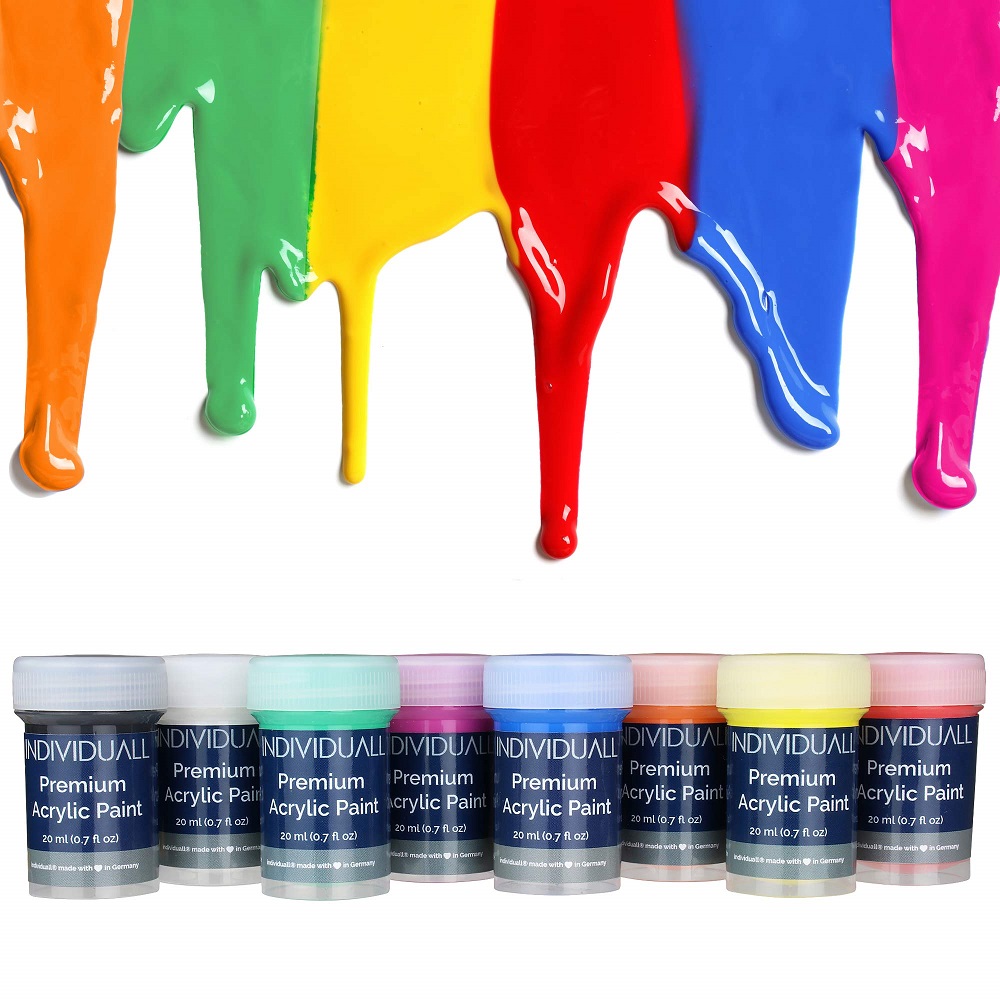Getting Started with Acrylics
Painting with acrylics for beginners can be an exciting venture into the world of art. Whether you are painting as a leisurely activity or seeking to create professional-quality work, understanding the basics of working with acrylics is essential. In this section, we’ll delve into the essentials that every fledgling painter should know—choosing your supplies, setting up an efficient painting space, and comprehending the properties of acrylic paints.
Choosing Your Supplies
The journey into painting with acrylics starts with gathering the right materials. Selecting quality supplies can make a significant difference in your painting experience and the resulting artwork. To get started, you will need:
- Acrylic Paints: Invest in a set of primary colors (red, yellow, blue) and black and white. These colors can be mixed to create a wide array of shades and tones.
- Brushes: A variety of sizes and shapes will help you explore different brush strokes. You can use stiff-bristle brushes for heavy body paints, while softer brushes are ideal for watered-down techniques and fine details.
- Canvas or Paper: Beginners might opt for acrylic paper pads, which are more affordable for practice. Canvases come pre-stretched and gessoed, offering a ready-to-use, durable surface.
- Palette: A palette is essential for mixing your paints. Disposable palettes or washable plastic ones are convenient options.
- Other Tools: Palette knives, sponges, and even old credit cards can be used for creating unique textures and effects.
Keep in mind that experimenting with different brands and types of supplies will help you understand your personal preferences and the unique qualities of each product.

Setting Up Your Painting Space
Creating a dedicated painting space is crucial for a beginner. It doesn’t have to be a large studio—a corner of a room or a portable easel can suffice. Here are a few tips to help you set up:
- Ensure good lighting, natural if possible, to see the true colors of your paint.
- Organize your supplies for easy access. Having everything within reach will keep you in the flow of painting.
- Cover your working area with a drop cloth or old newspapers to protect it from splatters and spills.
- Consider your comfort by choosing an ergonomic chair or stool.
- Maintain a clean space to avoid mixing unwanted dirt and particles into your paints and to keep a clear mind.
A well-organized painting environment supports creativity and can make your painting sessions more enjoyable.
Understanding Acrylic Paint Properties
Acrylic paints are loved for their versatility, quick-drying nature, and ease of use. Here are some properties to be aware of:
- Drying Time: Acrylics dry rapidly, which is great for working in layers but means you need to work swiftly or keep your paints moist with a sprayer or a stay-wet palette.
- Consistency: Acrylics come in various consistencies from fluid to heavy body. Fluid acrylics are great for glazing and wash techniques, while heavy body paints retain brushstrokes for impasto effects.
- Permanence: Once dry, acrylics are water-resistant, making them durable and long-lasting.
- Color Shifting: Acrylics tend to darken as they dry, a phenomenon known as ‘color shift’. Be prepared to adjust colors accordingly as you work.
By acknowledging these characteristics, you’ll be able to work with acrylics effectively and adapt your painting technique to achieve the desired results on your creative journey.

Basic Techniques for Beginners
Beginning your acrylic painting journey can be thrilling, and mastering a few basic techniques will set a solid foundation for your artistic exploration. Let’s delve into some beginner-friendly methods that will help you handle acrylic paints with confidence and creativity.
Mastering Water as a Medium
One of the primary techniques in painting with acrylics for beginners involves using water. You can use water to thin your paints, giving your artwork the appearance of watercolor with a matte finish. However, it’s important to be mindful of the surface you are painting on. Watercolor paper, being thick and absorbent, is ideal for this technique, whereas pre-gessoed or water-resistant canvases may not absorb the paint well, leading to drips and pooling effects. Starting with a light hand and gradually adding more water will help you to control the medium better and avoid over-saturating your painting surface.
Exploring Textures with Brushes and Other Tools
Brushes serve as your primary tool for applying paint, and you can also use them creatively to produce textures. Experiment with different bristles: stiff ones create a more textured surface, while soft ones work well for smoother applications. Other household items, such as paper towels, sponges, or even fingertips, are excellent tools for creating unique surfaces. Dabbing, scraping, and even layering with these tools can add depth and interest to your paintings with very little effort.
Experimenting with Stippling and Dabbing
Stippling is a technique where small dots of paint are applied to create texture or shading. This method is also useful in building up colors in layers to add depth to your artwork. With dabbing, you can use a stiff-bristle brush or crumpled paper towel to press paint onto the canvas, creating a varied, textured effect perfect for natural elements like sand, clouds, or foliage. Remember, the amount of pressure you apply will affect the density and spread of the texture, allowing for limitless possibilities.
Employing these techniques will not only enhance the visual appeal of your artwork but also give you a deeper understanding of how acrylic paints behave. Experiment with each method, and don’t hesitate to combine them for more complex and interesting results. As you gain more confidence, you will find your unique style and discover the endless creative potential that comes with painting with acrylics for beginners.
Advancing Your Skills
As you become more comfortable with the basics of painting with acrylics for beginners, it’s time to advance your skills and try new techniques. Challenges will serve as milestones to gauge your improvement and encourage creativity. Let’s explore ways to elevate your artistry with advanced acrylic painting methods.
Working with Layers and Acrylic Pouring
Layering is a dynamic technique in acrylic painting that allows for richness and depth. Acrylics dry fast, making them perfect for layering. Begin with a base layer, and once it’s dry, add successive layers to enhance details and texture. Experiment with opacity, mixing transparent and opaque layers to create different effects.
Acrylic pouring is another sophisticated technique that creates stunning abstract designs. It involves mixing acrylic paint with a pouring medium and then pouring it onto the canvas to create fluid, abstract patterns. You can manipulate the paint by tilting the canvas or using tools to swirl the paint, resulting in marbleized or cellular patterns. It’s a playful method that can yield surprising and striking results.

Achieving Precision with Palette Knives and Fine Brushes
Palette knives aren’t just for mixing paint. You can use them to apply paint to achieve sharp lines, create layers with visible strokes, or even scrape off paint for a subtractive technique. The versatility of the palette knife opens up a new realm of textural possibilities.
Fine brushes come into play when you’re looking to add details with precision. The tight, controlled nature of these brushes allows for intricate detail that can’t be achieved with larger, looser brushes. While palette knives can give you bold textural statements, fine brushes will enable you to create delicate lines and features, adding complexity and finesse to your painting.
Utilizing Color Mixing for Dynamic Effects
Color mixing is fundamental for artists to create harmony and contrast in their work. Understanding the color wheel and the relationships between colors is crucial. Experimenting with color mixing will help you learn how to mute, brighten, or alter hues to suit your artistic vision.
Creating a personalized color mixing chart can serve as a handy reference. Identify a range of hues from your primary colors by mixing them in various ratios and adding in white or black to lighten or darken tones. As you expand your palette through mixing, you’ll find unique shades that can give your painting a distinctive, personalized touch.
Mastering these advanced techniques requires practice, patience, and a willingness to experiment. Embrace mistakes as part of the learning process and keep pushing the boundaries of your creativity. With each new method you tackle, you’ll see your acrylic painting skills grow, and your artistic voice will become clearer.